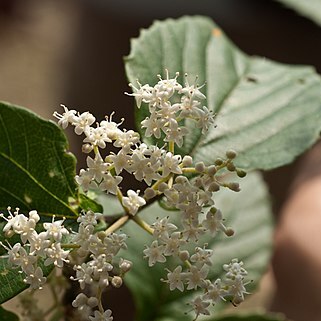Shrubs or small trees, deciduous, to 3 m tall. Bark light brown. Branchlets of current year yellow-brown stellate-pubescent; branchlets of previous year dark purple-brownish, terete, sparsely stellate-pubescent, with dispersed, small, rounded lenticels. Winter buds ovoid-oblong, with 2 pairs of separate scales; scales yellow-brown stellate-pubescent. Leaves always opposite, not clustered at apices of branchlets; stipules absent; petiole green, slender, usually 3-10(-15) mm, yellow-brown stellate-pubescent; leaf blade yellowish green when young, ovate, elliptic-ovate, or ovate-lanceolate to oblong, sometimes subrhombic, 4-9(-11) × 2-5 cm, papery to thickly papery, abaxially sparsely stellate-pubescent or forklike pubescent, adaxially with transparent glandular dots and forklike pubescent on midvein, midvein raised abaxially, lateral veins 5-9-jugate, pinnate, straight or slightly arched, rarely branched, ending in teeth, conspicuously raised abaxially, impressed adaxially, veinlets transverse, slightly raised abaxially, impressed adaxially, not lobed, base broadly cuneate to subrounded, with 0-2 circular glands on both sides of midvein near base, margin serrate, ciliate, apex acuminate to acute. Flowers appearing after leaves; inflorescence a compound umbel-like cyme, usually at apices of short lateral branchlets with a pair of leaves or terminal on branchlets, 3-5 cm in diam.; rays whorled; first node of inflorescence with 5 rays, dense, yellow-brown stellate-pubescent, or mixed with forklike or simple hairs, without large sterile radiant flowers; peduncle usually very short or nearly absent, very rarely to 1.5 cm; bracts and bracteoles deciduous, leaflike, green, lanceolate, hairy. Flowers on rays of 3rd and 4th orders, not fragrant, sessile or shortly pedicellate. Calyx yellowish green; tube ovoid-orbicular, ca. 1 mm, yellow-brown stellate-pubescent; lobes ovate-lanceolate, ca. 0.5 mm, ciliate, apex obtuse. Corolla white, rotate, 4-5 mm in diam., outside stellate-pubescent; tube ca. 1.5 mm; lobes spreading, ovate, exceeding tube, apex rounded, margin entire. Stamens shorter or slightly longer than corolla, inserted at base of corolla; filaments ca. 2 mm; anthers yellow-whitish, broadly elliptic, ca. 0.8 mm. Styles slightly exceeding calyx lobes; stigmas indistinctly 3-lobed. Fruit maturing red, ovoid, 5-6 mm, base rounded, apex rounded, glabrous; pyrenes very compressed, ovoid, 4-5 × 3-4 mm, with 3 shallow dorsal grooves and 2 shallow ventral grooves, base truncate, apex acute. Fl. Apr-Jun, fr. Aug-Oct.
More
Shrub 3-6 m high. Ultimate ramifications (often densely) ferrugineous-pubescent. Leaves extremely variable, chartaceous to subcoriaceous, young ones pubescent by simple antrorse and stellate hairs, more or less glabrescent, 3-8(-13) by 2-5 cm, ovate to lanceolate, apex acute to long acuminate, base broadly cuneate to rounded, often inequilateral, margins almost entire to sinuate-dentate in upper part; nervation prominent beneath, often hidden by indument; primary nerves 5-7 on each side, usually terminating in teeth, lower ones anastomosing; petioles densely pubescent, ½-1 cm. Inflorescence terminal or spuriously lateral, umbellate, corymbiform to semi-globose, 1-2 mm. Flowers slightly odorous, 3-5 mm wide. Calyx hardly 1 mm long, deeply lobed, lobes ovate-lanceolate, pubescent. Corolla rotate, globular in bud, creamy white or somewhat pink, strigose and stellate-pubescent without, glabrous within, tube very short ½ mm), lobes elliptic-oblong, rounded, 1½-2 mm. Stamens exserted, but shorter than corolla-lobes; filaments adnate to base of corolla, 1½-2 mm; anthers broadly elliptic, yellow, ½-¾ mm long. Ovary cylindric, densely pubescent, 1 mm long. Drupe ovate, much compressed, red (or ripening black?), (5-)6-7 by 5-6 mm. Endocarp slightly undulate in cross-section, the 2 dorsal and 3 ventral grooves often obsolete.
A shrub or small tree. It loses its leaves during the year. It grows 3 m tall. The leaves are opposite. They are 4-9 cm long by 2-5 cm wide. The flowers are in a compound groups at the end of side branches. The flowers are white. The fruit are red. The are 5-6 mm long.


